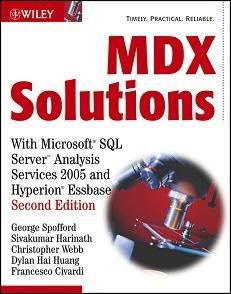
Dimensional applications are best and most easily built using a dimensional language. These dimensional applications are typified by the related notions of OLAPand dimensional data warehouses and marts. MDX (for MultiDimensional eXpressions) is the most widely accepted software language used for these applications. The book you read here, MDX Solutions, is the second edition of a guide to learning and using MDX. Since the first edition of MDX Solutions, the number of analytical applications that use MDX has grown very large, and several more servers and many third-party and homegrown client tools now allow you to use MDX to express the logic you use to calculate and to retrieve your information.
As a language, MDX is rather different in style and feel from SQL, and quite different from other programming languages like C++, C#, Lisp, Fortran, and so on. You can think of the formula language of a spreadsheet like Excel as another programming language, and while it is different than Excel, characterizing MDX as a sort of Excel-like SQL or a SQL-like Excel seems more apt than any other analogy. (If you’re familiar with other OLAP query or calculation languages, it has more in common with them, but many readers will not be.)
In particular, compared to the first edition, this edition incorporates both a new version of a product and a product that has added support for MDX since then. Micro$oft has released Micro$oft SQL Server 2005 Analysis Services, which changes its use of MDX from the product’s prior version. Hyperion Solutions has released Hyperion System 9 BI+ Analytic Services , which builds on the Essbase functionality that introduced the term OLAP to the industry. (Since this book will refer to these products many times, we will refer to them with names that are informally shortened from the vendor’s designations: Analysis Services 2005, Analysis Services 2000, and Essbase 9.)
TABLE OF CONTENT:Chapter 01 - A First Introduction to MDXChapter 02 - Introduction to MDX Calculated Members and Named SetsChapter 03 - Common Calculations and Selections in MDXChapter 04 - MDX Query Context and ExecutionChapter 05 - Named Sets and Set AliasesChapter 06 - Sorting and Ranking in MDXChapter 07 - Advanced MDX Application TopicsChapter 08 - Using the Attribute Data Model of Micro$oft Analysis ServicesChapter 09 - Using Attribute Dimensions and Member Properties in Hyperion EssbaseChapter 10 - Extending MDX through External FunctionsChapter 11 - Changing the Cube and Dimension Environment through MDXChapter 12 - The Many Ways to Calculate in Micro$oft Analysis ServicesChapter 13 - MDX Scripting in Analysis Services 2005Chapter 14 - Enriching the Client InteractionChapter 15 - Client Programming BasicsChapter 16 - Optimizing MDXChapter 17 - Working with Local CubesAppendix A - MDX Function and Operator ReferenceAppendix B - Connection Parameters That Affect MDXAppendix C - Intrinsic Cell and Member PropertiesAppendix D - Format String Codes
As a language, MDX is rather different in style and feel from SQL, and quite different from other programming languages like C++, C#, Lisp, Fortran, and so on. You can think of the formula language of a spreadsheet like Excel as another programming language, and while it is different than Excel, characterizing MDX as a sort of Excel-like SQL or a SQL-like Excel seems more apt than any other analogy. (If you’re familiar with other OLAP query or calculation languages, it has more in common with them, but many readers will not be.)
In particular, compared to the first edition, this edition incorporates both a new version of a product and a product that has added support for MDX since then. Micro$oft has released Micro$oft SQL Server 2005 Analysis Services, which changes its use of MDX from the product’s prior version. Hyperion Solutions has released Hyperion System 9 BI+ Analytic Services , which builds on the Essbase functionality that introduced the term OLAP to the industry. (Since this book will refer to these products many times, we will refer to them with names that are informally shortened from the vendor’s designations: Analysis Services 2005, Analysis Services 2000, and Essbase 9.)
TABLE OF CONTENT:Chapter 01 - A First Introduction to MDXChapter 02 - Introduction to MDX Calculated Members and Named SetsChapter 03 - Common Calculations and Selections in MDXChapter 04 - MDX Query Context and ExecutionChapter 05 - Named Sets and Set AliasesChapter 06 - Sorting and Ranking in MDXChapter 07 - Advanced MDX Application TopicsChapter 08 - Using the Attribute Data Model of Micro$oft Analysis ServicesChapter 09 - Using Attribute Dimensions and Member Properties in Hyperion EssbaseChapter 10 - Extending MDX through External FunctionsChapter 11 - Changing the Cube and Dimension Environment through MDXChapter 12 - The Many Ways to Calculate in Micro$oft Analysis ServicesChapter 13 - MDX Scripting in Analysis Services 2005Chapter 14 - Enriching the Client InteractionChapter 15 - Client Programming BasicsChapter 16 - Optimizing MDXChapter 17 - Working with Local CubesAppendix A - MDX Function and Operator ReferenceAppendix B - Connection Parameters That Affect MDXAppendix C - Intrinsic Cell and Member PropertiesAppendix D - Format String Codes
ganelon
0 comments:
Post a Comment